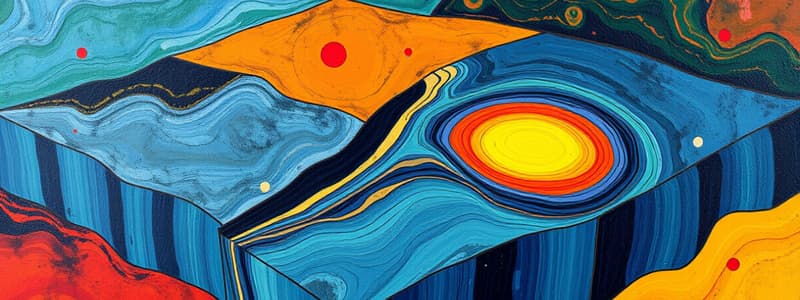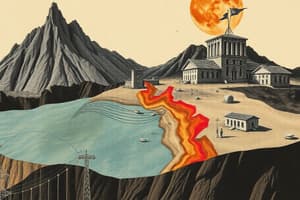Podcast
Questions and Answers
What causes a tsunami?
What causes a tsunami?
- Tides from the moon
- An earthquake or volcanic eruption (correct)
- Changes in sea temperature
- Strong winds over the ocean
Which process is a type of mechanical weathering?
Which process is a type of mechanical weathering?
- Formation of humus
- Dissolution in acidic water
- Oxidation of minerals
- Frost wedging (correct)
What is the purpose of a seismograph?
What is the purpose of a seismograph?
- To determine the location of volcanoes
- To measure the size of earthquake waves (correct)
- To predict future earthquakes
- To assess soil fertility
What describes a delta?
What describes a delta?
Which of the following is NOT a characteristic of lava?
Which of the following is NOT a characteristic of lava?
Flashcards are hidden until you start studying
Study Notes
Tectonic Plates and Earthquakes
- Tectonic plates are vast, moving shelves that constitute the Earth's crust, influencing geological activity.
- A fault is a fracture in the Earth's crust where movement occurs, often triggering earthquakes.
- Earthquakes arise when tectonic plates grind against or slip past each other, potentially causing significant violence.
- Seismographs are instruments used to measure the magnitude and waves generated by earthquakes.
- The epicenter is the ground location directly above where an earthquake originates, critical for assessing damage.
- The Richter scale quantifies seismic wave data to evaluate the relative strength of earthquakes.
Tsunamis and Volcanoes
- Tsunamis are colossal ocean waves generated by underwater earthquakes or volcanic eruptions, known for their destructive force.
- Volcanoes form when magma, gases, and water from the Earth's lower crust or mantle accumulate and erupt through surface cracks.
- Lava is effectively magma that has breached the Earth's surface during a volcanic eruption.
- The Ring of Fire is a notable geographical area characterized by a series of active volcanoes along the Pacific Rim.
Weathering, Erosion, and Soil Formation
- Weathering involves physical and chemical processes that alter rock characteristics at or near the Earth's surface over time.
- Sediment consists of small rock fragments produced through weathering processes.
- Mechanical weathering physically breaks down rocks into smaller pieces without changing their composition.
- Chemical weathering transforms rocks into new substances through reactions with air and water elements acting on minerals.
- Erosion is a result of weathering and involves the transport of materials via wind, water, ice, or gravity.
Landforms and Soil Types
- A delta is a fan-like landform created by sediment deposited at the river's mouth when it slows down upon entering the ocean.
- Loess refers to wind-blown deposits of silt and clay, resulting in highly fertile soil conducive to agriculture.
- Glaciers are extensive, persistent masses of ice that move under gravitational forces, reshaping landscapes.
- Glaciation describes the alteration of landforms caused by the slow movement of glaciers over time.
- A moraine is a mound or ridge of debris left behind by a glacier, marking its previous position.
- Humus is the organic component of soil, formed from decomposed matter, essential for plant growth and soil fertility.
Studying That Suits You
Use AI to generate personalized quizzes and flashcards to suit your learning preferences.



